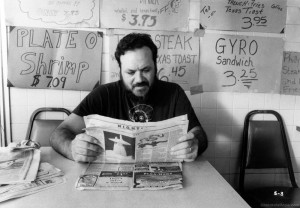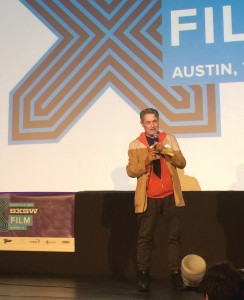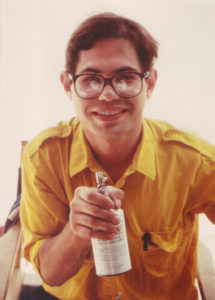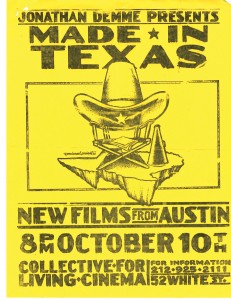Demme had been a hero of mine since 1975, when I saw him directing Cloris Leachman in Crazy Mama on Sunset Boulevard in Los Angeles. I had been invited to the set by fellow Fort Worth expat Bill Paxton, who was a production assistant on and bit player in the film.
In the spring of 1981, Demme was enjoying his first mainstream success with Melvin and Howard when he visited Austin and fell in love with the short films made by our tightknit group of film students and punk rockers. He was introduced to the films by Black, co-director of one of the movies.
Demme carried prints of Invasion of the Aluminum People, Speed of Light, Fair Sisters, Mask of Sarnath, Leonardo Jr., and The Death of Jim Morrison home to New York City to present them at the Collective for Living Cinema. The screening was sold out. He also had arranged for reviews by major critics, wrote glowingly about the films himself in The New York Rocker, and showed them to Italian director Bernardo Bertolucci, who took a particular shine to Speed of Light, written by Paul Cullum of Fort Worth.
A few years later, a young Rick Linklater, on leave from his offshore oil-rigging job in the Gulf of Mexico, caught two of the films, Speed of Light and Aluminum People. Blown away, he relocated to Austin to make movies, where he befriended Black. Together they cofounded the Austin Film and Video Society. In 1991 Linklater directed the breakout indie hit Slacker, co-starring Black.

In 1997, SXSW, originally a music festival that expanded to include film, featured the world premiere of Traveller, produced by and starring Paxton, on which I was the music supervisor. At the after-party, I got to meet Linklater, whom I admired for his accomplishments and his resistance to the siren call of Hollywood.
A few years ago, Black launched a crusade to restore and distribute lost films from the history of Texas independent filmmaking. When he first contacted me about reassembling the films from Made in Texas as a commercial product, I wondered about their relevance. I also reminded him that I did not have rights to the music and thought that he might also need to acquire Morrison’s life rights from his estate. But it’s hard to say no to Louis Black or erect obstacles he cannot overcome
In March 2015, on opening night at SXSW, Demme, Linklater, and Black hosted the world premiere of Jonathan Demme Presents: Made in Texas, with all six films painstakenly restored by Mark Rance of Watchmaker Films.
The package is touring the festival circuit and anticipating its online release.
As for my film, it’s got a new score and a new title, Death of a Rock Star, for legal and ethical reasons.
******

As I understand it, Demme’s first contact with our crew was with Nick Barbaro at the Venice Film Festival in 1980, where Melvin and Howard was having its European premiere. Barbaro, whose only credential was writing for our school paper, The Daily Texan, had no way of knowing that Demme, an early adopter of New Wave, was listening obsessively to a compilation tape of Austin punk bands, including Standing Waves, F-Systems, Radio Free Europe, and my bands, The Huns and The Reversible Cords.
Barbaro was wearing a Huns t-shirt.
“You know the Huns?!” Demme exclaimed.
“I got busted with them!” Barbaro replied.
An instant bond ensued, with a standing invitation for Demme to visit Austin to see the bands he admired. But by the time Demme got to Austin in the spring of 1981, many of the bands, including both of mine, had broken up. On the last day of his visit, he saw the six films that had been created by some of the same young artists who had made the music he cherished. Demme loved the movies as much as the music and vowed to introduce them to a wider audience.

Unfortunately, I missed all this, including the Manhattan screening. I was in the middle of post-production on Taking Tiger Mountain, starring Paxton and co-written by Cullum and William S. Burroughs. Brian Hansen’s exploratory noise confederation, Radio Free Europe, provided the soundtrack. I’d headed back to Hollywood, where it was cheaper to finish the film than in Austin.
Meanwhile, Hansen, a multidisciplinary and visionary artist, polymath, and raconteur, moved to Los Angeles and leased an apartment with me. Demme arrived soon after to direct Swing Shift, starring Goldie Hawn and Kurt Russell.
Hansen and I visited Demme on the set, befriended his pals, and attended the L.A. premiere of his side project, the Talking Heads concert film Stop Making Sense, a dancing-room-only extravaganza at the Hollywood Palace in October 1984.
Only weeks before, Demme had been fired from Swing Shift during post-production. For years afterward, he called it the worst thing that ever happened to him. The agony of Swing Shift was trumped by the triumph of Stop Making Sense, universally regarded as one of the best music documentaries ever made. It launched Demme into overdrive as a singular artistic force, a hip household name associated with diversity, quality, and foresight. He followed it with a string of masterpieces, including Something Wild, Swimming to Cambodia, Married to the Mob, The Silence of the Lambs, and Philadelphia.
In 1982 in L.A., I was showing The Death of Jim Morrison on The Doors’ own turf and meeting people who knew them. No One Here Gets Out Alive was a bestseller, and the headline to a Rolling Stone cover story on Morrison blared, “He’s Hot, He’s Sexy, He’s Dead.” There were rumors of a feature in development with John Travolta’s name attached.
I attended a gallery opening of Doors photos by Frank Lisciandro, Morrison’s best bud from film school. Lisciandro and I spoke briefly, and I got his address to send him a VHS copy of my film. He called a few days later and said, “First, let me tell you that your film is the kind of thing that Jim and I were trying to make at UCLA, but we didn’t have the skill.”
“Wow, thanks!”
“However,” Lisciandro said, “it has nothing to do with the Jim Morrison I knew and loved. The Jim Morrison I knew and loved was a true Southern gentleman. He would stand up when a woman walked in the room. He wouldn’t raise his voice in a woman’s presence …”
He paused.
“Except when he was drunk.”
About the same time, I got to visit with Doors organist Ray Manzarek and his wife at a reception for author William S. Burroughs but refrained from mentioning my film for fear of spoiling the moment.
I sent the film to Jac Holzman, founder of The Doors’ record label, Elektra, who was retired and living in Hawaii. He responded with a letter: “I watched what I could of your tape, but my experience of Jim was so personal and the implications … that he may have been willfully murdered so outlandish that I ceased viewing it at the point where you dumped him in the bathtub … .”
After that, I stopped trying to get the rights to “When the Music’s Over.”
I never bothered seeking Morrison’s life rights, which were controlled by the parents of his common-law-wife, Pamela Courson, who overdosed on heroin in 1974. The Coursons were vexed by the racier bits of No One Here Gets Out Alive. No way they’d appreciate my movie.
In 1984, I took a class at The Hollywood Scriptwriting Institute, where all the students read aloud from their work, except for one painfully shy woman named Judy in the back row. The teacher asked if she minded if he read an excerpt from her script. Judy, about 30, peeking out through a veil of long frizzy hair, nodded. The teacher read a gut-wrenching scene about a rock star anally raping a groupie on their first meeting. The names were changed, but I suspected the rock star was Morrison. I introduced myself to Judy and told her my theory. She admitted the scene was about her and Morrison.
I bought Judy dinner, and we became friends. She was desperate for people to hear her story. Eventually, they did: Judy Huddleston was a credited consultant on Oliver Stone’s The Doors and the author of two published books about her relationship with Morrison. She watched our movie and said we had expertly captured a side of Morrison she knew too well, the side his bandmates called “Jimbo.”
In 1989, I was at a party and spotted Val Kilmer, dressed in leather pants with long hair. I knew he’d been cast to play Morrison in The Doors. Paxton, who had lobbied for the part of Morrison with the support of Doors guitarist Robby Krieger, introduced me to Kilmer as an expert on Morrison. We had a nice chat until I asked if he would be doing his own singing.
“Yes, why?” Kilmer said defensively.
“Well,” I said, choosing my words carefully, “that’s the one thing everyone knows: what Morrison sounds like singing.”
Kilmer huffed and walked away.
Later, when the film came out, I liked it, though Kilmer’s performance struck me as cold and calculated. (He’d been amazing as Ice Man in Top Gun.) In retrospect, the fact that he got so close to capturing Jim and Jimbo was a minor miracle.
Which leads me to the late Jeff Whittington, who played Morrison in our film. He was a celebrated music reporter at The Daily Texan and lived at my co-op. He looked a lot like Morrison but had no performing experience. Also, he was nervous around women and homophobic (a problem, as I intended to portray Morrison as bisexual). But after my first two choices had passed …
I don’t know why Whittington said yes except maybe to meet girls. We struggled to get him to emote — especially in the love scenes, which apparently he enjoyed. We ended up pruning his part, focusing on what Morrison was seeing rather than doing. Then came a breaking point: a scene in a public restroom where Morrison was to receive head from another man through a glory hole. Despite there being no actual hole, Whittington refused to pretend to have gay sex. Instead, I did the scene myself, along with the Huns’ lead singer, Phil Tolstead, on the other side of the stall.
Afterward, Whittington stopped talking to me and threatened to quit. So my partner, van Overbeek, shot the lead actor’s remaining bits without me.
A few more behind-the-scenes stories from The Death of Jim Morrison:
Whittington lay in a gutter on 6th Street about midnight on a weeknight, playing Jimbo passed out drunk. A lone cop in a squad car pulled up and threatened to arrest us for vagrancy or something. Sally Norvell, who played Morrison’s paramour in the film, charmed Officer Steve Bridgewater into joining the cast. Handcuffing our Morrison and loading him into the squad car, Bridgewater almost stole the film with his John Wayne-like performance.
Two months later, this same cop famously put the kibosh on The Huns’ debut at the notorious punk bar Raul’s, resulting in the arrest of Tolstead, who “assaulted” Bridgewater with a kiss on the lips, sparking a riot. Seven friends of ours were also seized and accompanied Tolstead to jail, including Barbaro, who called a cop an asshole.
The film’s climax was based on a legend long debated in Doors circles. Our version would show Morrison going out to the desert with friends to take peyote, where they encounter a gang of bikers, who kills one of the friends, played by myself. Norvell and her friend, Kati Bell, were dating members of an Austin motorcycle club, Greasy Joe and Hollywood respectively. They liked to party on a barren mountaintop west of Austin. We could shoot there and have the whole gang for the cost of a few cases of beer.
As the night dragged on, the beer ran out and the bikers grew restless. Norvell and Hollywood, the club’s president, kept them from bailing.
A diminutive, wall-eyed biker appropriately called Chuck Manson was cast to slit my throat with a pocketknife. To achieve the illusion, we would shoot a close up of Manson opening the blade. Then, in the long shot when he kills me, the blade would be closed for safety. Manson wanted the blade out for realism’s sake. We quarreled. Hollywood intervened, kept me from getting stomped, and convinced Manson to do it my way.
After getting the footage back from the lab, it was 90 percent out of focus due to a busted lens on the ancient 16mm Bolex we were using. Van Overbeek cried. I got the idea of taking a shot of Morrison chugging a bottle of whiskey while defocusing the lens to match the “ruined” footage. Crisis averted.

Flash forward 28 years to 2006: Although we had a number of friends in common, I’d never met my favorite drummer, John Densmore. I was co-directing DVD extras for the 35th anniversary re-release of The Harder They Come, about a rural Jamaican musician (Jimmy Cliff) hitting the big time in Kingston, and arranged to interview Densmore as an expert on reggae. The former Doors’ drummer proved to be warm, humble, generous, thoughtful, and articulate. I refrained from mentioning The Death of Jim Morrison, as I had done with Manzarek. Based on everything I knew about Densmore, I figured he would hate it.
When Black began accumulating the parts for Made in Texas in late 2014, he e-mailed Densmore about securing the rights to “When the Music’s Over.” Densmore didn’t respond. Faced with the prospect of leaving the film out altogether, Black commissioned an original score by Adrian Quesada, who turned in a superb Doors-like musical suite.
It was my suggestion to change the name to Death of a Rock Star. I like to think that Morrison would have dug the film, but that’s not enough to expect the surviving band members or those controlling Morrison’s estate to put their imprimatur on it. I wouldn’t if I were them.
The quality of the image on all of the films is astounding. None of them looked this good when they first came out of the lab way back when. Our film for instance, which combines black and white with color sequences, originally had to be printed on color stock so the b&w sections had a funky blue tint. Now, that’s fixed. Mistakes I made in splicing the negative are gone, too.
Check it out for yourself and look for more releases of restored films from Louis Black and Watchmaker Films, who are doing for Texas film what Martin Scorsese’s Film Foundation does for world cinema.












All of my favs in one article: music, films, Texas (Austin that is) and the history of my youth. All this inside scoop from one who was on the cutting edge of cool. Alas, it was not me, I was always a fringe fan, so my heroes were there mixing it up. I admire those who lead with a true artist heart; who were in it for expression of the times. Throwing the American dream back in the face of established values with questions of loyalty to a facade.
So much energy and brilliance all around me, exciting stuff, to expand thoughts and powerful changes. It shaped who I am and for that I am grateful. I can look back and still get excited and provoked. I need to see these films. I need to be shocked and motivated again to see how art is reflected by culture. Or is it that artist that leads culture?
I can not wait to buy the DVD. Great article!
Great piece — superb storytelling. I saw The Death of Jim Morrison at the SFAI Cinematheque in 1981 — part of a “punk/new wave” film festival. It is the only film I truly remember from that night.
I’ve looked for it for years. Last week an old girlfriend sent me a box of my stuff found in her attic. It had a SF Chron story about the film festival and mentioned “Morrison’s” director, uh….you!
Having THAT piece of info, I tracked down this article AND the Demme/Black DVD set. It’s on the way! Can’t wait to see all the films, but especially TDOJM after 38 years. That mushroom soaked
night was one of my favorite SFAI “trips” of all-time.
Best to you, Mr. Huckabee. You made a fine-ass film.
Much obliged, Aitch. Get in touch if you like. i’m at t.huckabee@icloud.com